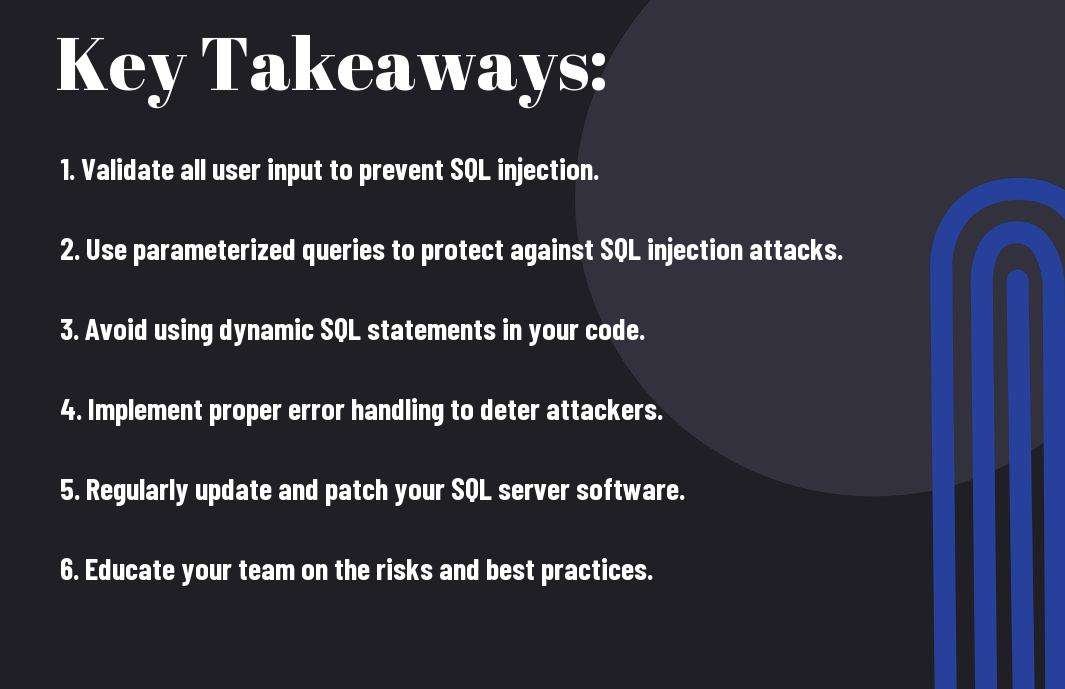Protecting your data is crucial in today’s digital landscape. SQL injection attacks are one of the most dangerous threats to your database security. In this listicle, I will share my top 10 tips to help you prevent these attacks and keep your data safe. Let’s dive in and strengthen your defenses against malicious intruders.
Key Takeaways:
- Use Parameterized Statements: This is the most effective way to prevent SQL injection attacks as it separates SQL code from user input.
- Input Validation: Validate and sanitize all user inputs to prevent malicious SQL code from being executed.
- Implement Least Privilege Principle: Limit database user permissions to only what is necessary to perform their specific tasks, reducing the risk of potential attacks.
Use Prepared Statements
Your data is valuable and must be protected at all costs. One of the most effective ways to prevent SQL injection attacks is by using prepared statements. By using prepared statements, you can ensure that your SQL queries are secure and free from malicious code injections.
Parameterized Queries
There’s no room for error when it comes to protecting your data. Parameterized queries are a powerful tool in the fight against SQL injection attacks. By using parameterized queries, you can separate the SQL code from the user input, preventing attackers from manipulating your queries.
Dynamic SQL Avoidance
You don’t want to leave any vulnerabilities in your code that could be exploited by malicious actors. By avoiding dynamic SQL, you can further secure your application against SQL injection attacks. Dynamic SQL allows for the creation of SQL statements on the fly, opening up the possibility of injection attacks.
It is crucial to restrict the use of dynamic SQL in your code and instead opt for prepared statements and parameterized queries whenever possible. By implementing this best practice, you can significantly reduce the risk of SQL injection attacks and protect your valuable data.

Input Validation Rules
While implementing input validation rules, it’s crucial to have a structured approach to prevent SQL injection attacks. By setting strict rules for the type and format of data that can be accepted by your application, you can significantly reduce the risk of malicious SQL injections.
Whitelisting Input Data
There’s one effective method I always recommend – whitelisting input data. This means only allowing specific, pre-approved characters, symbols, and formats in your application’s input fields. By permitting only known safe inputs, you can dramatically reduce the chances of SQL injection attacks.
Error Handling Mechanisms
Input validation rules alone may not be foolproof. Error handling mechanisms are also critical in safeguarding your application against SQL injections. By properly coding error messages and responses, you can prevent potential attackers from gaining insights into your database structure.
Any improper error handling can expose sensitive information about your database and make it vulnerable to SQL injection attacks. By carefully crafting error messages and limiting the details revealed to users, you can enhance the security of your application.
Limit Database Privileges
Least Privilege Principle
Unlike giving users unrestricted access to your database, applying the principle of least privilege ensures that each user or process has only the bare minimum permissions necessary to perform their job functions. By restricting access to only the required tables, columns, and rows, you significantly reduce the risk of a potential SQL injection attack.
Role-Based Access Control
While implementing the role-based access control model, you can assign specific roles to users based on their responsibilities within the organization. This means that each user is granted access based on their role, rather than individual privileges. Access is limited to only the necessary functions required for that specific role, adding an extra layer of security to your database.
To further enhance security, role-based access control allows you to easily manage user permissions by simply adding or removing roles as needed. This not only simplifies the management process but also ensures that users have appropriate access levels at all times.
Keep Software Up-to-Date
Regular Security Patches
After setting up your database and applications, you’ll want to ensure that you regularly update them with the latest security patches. Manufacturers release these patches to fix vulnerabilities that could be exploited by hackers. By staying current with security patches, you can fortify your defenses against SQL injection attacks.
Outdated Software Risks
While it may be tempting to postpone software updates, especially when everything seems to be running smoothly, you’ll expose your system to significant risks by neglecting to upgrade. Outdated software is a prime target for hackers looking to exploit known vulnerabilities. By leaving your software unpatched, you create an open invitation for malicious actors to breach your system and compromise your sensitive data.
Plus, using outdated software can also impact your system’s performance and compatibility with other applications. So, it’s imperative to prioritize timely updates to not only enhance security but also ensure smooth operations across the board.
Avoid Dynamic SQL
Your website’s database is vulnerable to SQL injection attacks when you use dynamic SQL. Dynamic SQL allows you to construct SQL statements at runtime, based on user input or other factors. However, this flexibility can also open up security holes that attackers can exploit.
Stored Procedures Usage
There’s a safer alternative to dynamic SQL – using stored procedures. Stored procedures are pre-written SQL queries that are stored in the database and called from your application. By utilizing stored procedures, you can prevent attackers from injecting malicious SQL code into your database.
SQL Injection Prevention
On top of using stored procedures, you should also implement input validation and parameterized queries to prevent SQL injection attacks. Input validation involves filtering and sanitizing user input to ensure that it does not contain any malicious SQL code. Parameterized queries separate SQL code from user input, making it impossible for attackers to manipulate the SQL statements.
Dynamic SQL poses a significant security risk to your database. By avoiding dynamic SQL and adopting safer practices like stored procedures, input validation, and parameterized queries, you can protect your data from SQL injection attacks and safeguard your website’s security.
Monitor Database Logs
Once again, monitoring your database logs is crucial to protect your data from SQL injection attacks. Database logs can provide valuable insights into any unauthorized access attempts or suspicious activity. By regularly reviewing your logs, you can detect and respond to potential threats before they escalate.
Real-Time Log Analysis
Assuming you have the resources, investing in real-time log analysis tools can enhance your ability to detect and respond to SQL injection attacks promptly. These tools can automatically scan your database logs for any unusual patterns or suspicious queries, alerting you to potential threats in real-time. By leveraging real-time analysis, you can take immediate action to mitigate the risks and prevent data breaches.
Suspicious Activity Detection
Any unusual patterns or unauthorized access attempts in your database logs should raise a red flag. It is vital to set up alerts for suspicious activities such as multiple failed login attempts, unusual query strings, or unauthorized access to sensitive data. By proactively monitoring and investigating these activities, you can identify and block potential SQL injection attacks before they compromise your data.
Suspicious activity detection plays a crucial role in preventing SQL injection attacks. By setting up alerts and regularly monitoring your database logs for any unusual activities, you can effectively protect your data from malicious intrusions. Being proactive in detecting and responding to suspicious behavior is key to maintaining the security of your database.
Use Web Application Firewall
Now, one of the most effective ways to protect your data from SQL injection attacks is to use a Web Application Firewall (WAF). A WAF acts as a barrier between your web application and any potential threats, such as malicious SQL injection attempts. It can help detect and block SQL injection attacks before they reach your database, keeping your data safe and secure.
SQL Injection Filtering
Firewall With SQL injection filtering capabilities, a WAF can inspect incoming traffic and filter out any suspicious SQL injection attempts. By analyzing the requests sent to your web application, the WAF can identify and block any malicious code that tries to manipulate your database.
Traffic Monitoring Tools
On top of SQL injection filtering, a WAF also often comes with Traffic Monitoring Tools that allow you to monitor and analyze the traffic coming to your web application in real-time. These tools can give you insights into the types of requests being made, potential vulnerabilities, and any suspicious patterns that may indicate an SQL injection attack.
Traffic Monitoring Tools can also help you identify and block any abnormal traffic that could potentially harm your database. By keeping a close eye on your web application’s traffic, you can quickly respond to any suspicious activities and prevent SQL injection attacks before they cause any damage.
Implement Encryption Methods
Data-at-Rest Encryption
Implementing data-at-rest encryption is crucial to safeguarding sensitive information stored in databases. By encrypting data at rest, you add an extra layer of security that prevents unauthorized access to your data, even if the database is compromised. This encryption method ensures that data is unreadable without the proper decryption key, making it extremely difficult for attackers to exploit vulnerabilities such as SQL injection to steal your data.
Data-in-Transit Encryption
You can enhance your data protection strategy by implementing data-in-transit encryption. This encryption method secures the communication channels between your application and the database, ensuring that data exchanged during transactions is encrypted and protected from interception by malicious actors. By using secure communication protocols like TLS/SSL, you can establish secure connections that prevent eavesdropping and tampering of sensitive information in transit.
With data-in-transit encryption, you not only protect your data from potential breaches during transmission but also demonstrate a commitment to data security best practices. Encrypting data in transit is necessary for maintaining compliance with data protection regulations and building trust with your users, who expect their sensitive information to be handled securely.
Perform Regular Security
Once again, I cannot stress enough the importance of performing regular security checks to protect your data from SQL injection attacks. These checks are imperative to identify and patch any vulnerabilities in your system before attackers exploit them.
Vulnerability Assessments
There’s no better way to understand the weaknesses in your system than by conducting regular vulnerability assessments. These assessments involve scanning your network and applications for known vulnerabilities and misconfigurations that could be exploited by attackers. By identifying and addressing these issues promptly, you can significantly reduce the risk of SQL injection attacks.
Penetration Testing Tools
With penetration testing tools, you can simulate real-world cyber attacks to test the security of your system. These tools, such as Metasploit and SQLMap, help uncover vulnerabilities that could be exploited by attackers, including SQL injection vulnerabilities. By using these tools regularly, you can proactively identify and fix security issues before they are leveraged by malicious actors.
Penetration testing tools are imperative for assessing the effectiveness of your security controls and ensuring that your defenses are robust enough to withstand potential attacks. Regularly using these tools as part of your security strategy will help you stay one step ahead of cyber threats and protect your data from SQL injection attacks.
Educate Developers Team
SQL Injection Awareness
All developers on your team should be aware of the potential risks associated with SQL injection attacks. I recommend conducting regular training sessions or workshops to educate your team on the various techniques that hackers use to exploit vulnerabilities in your code. By increasing awareness and understanding of these attacks, you can empower your developers to write more secure code and prevent SQL injection vulnerabilities.
Secure Coding Practices
There’s no substitute for secure coding practices when it comes to preventing SQL injection attacks. I suggest implementing input validation and parameterized queries in your codebase to mitigate the risk of SQL injection vulnerabilities. Additionally, I recommend using stored procedures or ORMs to handle database interactions, as these methods can help prevent SQL injection attacks.
Plus, remember to regularly review your codebase for any potential vulnerabilities and follow best practices for secure coding, such as using prepared statements and avoiding dynamic SQL queries. By prioritizing secure coding practices, you can significantly reduce the risk of SQL injection attacks on your application.
Use ORM Frameworks
Keep in mind that using Object-Relational Mappers (ORMs) can help prevent SQL injection attacks by parameterizing the queries automatically. This can make it much harder for attackers to inject malicious SQL code. If you are not familiar with ORM frameworks, I highly recommend checking out the SQL Injection Prevention Cheat Sheet for more information on how to protect your data.
Object-Relational Mappers
On using ORM frameworks, I find that they can abstract away the need to directly write SQL queries, reducing the risk of SQL injection vulnerabilities. With ORMs, you can work with your data in a more object-oriented manner, making your code cleaner and more secure. ORM frameworks automatically escape input parameters and enforce parameterized queries, making it much harder for attackers to manipulate your SQL queries.
SQL Abstraction Layers
For SQL Abstraction Layers, I must say that they provide another level of protection by abstracting the database interaction entirely. By using an SQL abstraction layer, you can further secure your application from direct SQL injection attacks. These layers often have built-in query builders that automatically sanitize and escape input, making it extremely difficult for attackers to inject malicious code.
The implementation of a SQL abstraction layer can add an extra layer of security to your application. While ORM frameworks handle the mapping between objects and relational databases, SQL abstraction layers take it a step further by completely abstracting the database interaction, providing an additional barrier against potential SQL injection attacks.
Disable Error Messages
Error Message Suppression
Despite the convenience of error messages for troubleshooting, they can also provide valuable clues to attackers trying to exploit your system through SQL injection. By hiding error messages from users, you can prevent attackers from gaining insight into your database structure and potential vulnerabilities.
Information Disclosure Prevention
Even if error messages are suppressed, certain configurations or settings may still leak valuable information to potential attackers. I recommend you carefully review and adjust your server and application settings to ensure that you are not inadvertently disclosing sensitive details that could be used in SQL injection attacks.
It is crucial to remember that even the smallest piece of information disclosed through error messages or server configurations can be exploited by attackers to gain unauthorized access to your database. Taking proactive steps to prevent information disclosure can greatly enhance the security of your system.
Use Escaping Mechanisms
Unlike other security measures, using escaping mechanisms is a crucial step in protecting your data from SQL injection attacks. These mechanisms help prevent malicious SQL code from being injected into your database queries, thereby safeguarding your system from potential breaches.
String Escaping Techniques
Techniques such as parameterized queries and stored procedures can help in escaping special characters in strings before executing SQL queries. By using these methods, you can ensure that user input is treated as data rather than executable code, significantly reducing the risk of SQL injection attacks.
Special Character Handling
Even though string escaping techniques are effective, special character handling is equally important in preventing SQL injection attacks. It involves identifying and encoding special characters that may be exploited by attackers to manipulate database queries. By handling special characters properly, you can protect your system from potential vulnerabilities and unauthorized access.
The key to successful special character handling lies in understanding the types of characters that can be used in SQL injection attacks. By implementing robust special character handling mechanisms, you can fortify your system’s defenses and minimize the risk of data breaches.
Implement Account Lockout
Brute Force Attack Prevention
One of the most effective ways to prevent SQL injection attacks is to implement an account lockout policy. This means that after a certain number of failed login attempts, the user’s account will be locked, preventing further login attempts. By implementing this measure, you can protect your database from malicious actors trying to gain unauthorized access through brute force attacks.
Excessive Login Attempts
Any system that involves user authentication should have safeguards against excessive login attempts. I recommend setting a reasonable limit on the number of failed login attempts allowed before an account is locked. This can help prevent attackers from continuously trying different combinations of usernames and passwords until they find a match.
Login throttling can also be implemented, which introduces a delay between login attempts after a certain number of failures. This helps prevent automated scripts from rapidly trying different credentials, making it harder for attackers to guess valid login credentials.
Use Secure Password Hashing
Salted Password Hashing
If you want to protect your users’ passwords from SQL injection attacks, you must implement salted password hashing. Adding a unique random value to each password before hashing it makes it significantly harder for attackers to crack the passwords, even if they have access to the hashed values.
Password Cracking Prevention
Password cracking prevention is crucial in safeguarding your system against unauthorized access. Use a strong hashing algorithm such as bcrypt or Argon2, which are designed to be slow and computationally intensive, making it challenging for attackers to quickly crack passwords. Additionally, regularly updating your hashing algorithms and periodically rehashing passwords can enhance security.
If your system implements proper password cracking prevention measures, even if attackers gain access to your hashed passwords, it will take them a significantly longer time to decipher the passwords, giving you a chance to detect and prevent any potential breaches.
Limit Database Connections
Your What is SQL Injection (SQLi) and How to Prevent Attacks starts with understanding the importance of limiting the number of connections made to your database. By minimizing the number of connections, you can reduce the attack surface for potential SQL injection threats. Here are some key strategies to help you limit database connections and keep your data secure.
Connection Pooling Limits
On a technical level, connection pooling is a method used to manage a pool of database connections that can be reused, rather than creating a new connection every time a user needs to access the database. By setting limits on the number of connections in the pool, you can prevent potential SQL injection attacks from overwhelming your database server. Implementing connection pooling limits also helps optimize resource usage and reduce the risk of unauthorized access to your database.
Resource Exhaustion Prevention
If your database server becomes overwhelmed with excessive requests, it can lead to resource exhaustion and potential vulnerabilities that could be exploited by attackers. By implementing safeguards like rate limiting and request throttling, you can protect your database from being overloaded and help prevent SQL injection attacks. Monitoring and analyzing your database traffic can also provide valuable insights into potential threats and help you proactively defend against malicious activities.
This proactive approach to resource exhaustion prevention is imperative to maintaining the integrity and security of your database. By staying vigilant and implementing effective security measures, you can strengthen your defenses against SQL injection attacks and safeguard your valuable data.
Use Secure Communication
SSL/TLS Encryption Protocols
Many SQL injection attacks occur due to data being transmitted over unsecured channels, making it easy for hackers to intercept and manipulate sensitive information. With SSL (Secure Sockets Layer) and its successor TLS (Transport Layer Security) encryption protocols, you can ensure that communication between your application and the database server is encrypted and secure. These protocols establish a secure connection, encrypting data in transit and preventing unauthorized access.
Man-in-the-Middle Attack Prevention
Many SQL injection attacks happen through a technique called man-in-the-middle attack, where a hacker intercepts communication between the application and the database server to eavesdrop or alter data. Attack prevention measures such as SSL/TLS certificates and secure communication protocols can help safeguard against this type of attack. It is crucial to implement proper security measures to protect your data from being compromised.
It is important to regularly update your SSL/TLS certificates and follow best practices for secure communication to mitigate the risk of man-in-the-middle attacks. By staying vigilant and proactive in securing your communication channels, you can significantly reduce the chances of falling victim to malicious interception.
Perform Regular Backups
Keep your data safe by regularly backing it up. This is one of the most crucial steps in protecting your data from SQL injection attacks. By performing regular backups, you can ensure that even if your data is compromised, you have a recent copy that you can restore.
Data Backup Strategies
On a regular basis, back up your databases to an external storage device or a secure cloud service. This will protect your data in case of any unforeseen circumstances that may lead to data loss. Additionally, consider implementing an automated backup system to ensure that your backups are up to date.
Disaster Recovery Planning
Strategies for disaster recovery planning are imperative in ensuring the continuity of your business operations in case of a data breach. I recommend creating a comprehensive plan that outlines the steps to take in the event of a security incident. This should include procedures for data restoration, communication with stakeholders, and steps to mitigate further risks.
Backup your data regularly is not enough; you must also have a well-thought-out disaster recovery plan in place. This will help you minimize the impact of a SQL injection attack and ensure the security and integrity of your data.
Continuously Monitor Systems
Real-Time System Monitoring
Not monitoring your systems in real-time can leave you vulnerable to SQL injection attacks. Some attackers may exploit this gap to inject malicious code into your databases undetected. Real-time system monitoring is a crucial defense mechanism to detect and respond to any suspicious activities immediately.
Anomaly Detection Systems
Monitor anomaly detection systems are vital for identifying unusual patterns or behaviors that deviate from normal activity. You can configure these systems to alert you when potential threats, such as SQL injection attempts, are detected. By leveraging anomaly detection, you can proactively protect your data and prevent unauthorized access to your databases.
Not having an effective monitoring and detection system in place can expose your organization to significant risks. Regularly monitoring your systems in real-time and implementing anomaly detection mechanisms are critical steps in protecting your data from SQL injection attacks.

Establish Incident Response
Incident Response Plans
All organizations must have incident response plans in place to effectively address and mitigate the impact of security incidents. This plan outlines the steps to be taken when a security breach, such as a SQL injection attack, is detected. I recommend developing and regularly updating this plan to ensure it aligns with the latest threats and technologies.
Emergency Response Procedures
When a security incident occurs, emergency response procedures are crucial for quickly containing the breach and minimizing the damage. You should have designated personnel trained to execute these procedures efficiently. Having clear communication channels and predefined roles and responsibilities can make a significant difference in the outcome of a security incident.
Response: In the event of a SQL injection attack, time is of the essence. Immediate isolation of the affected system and forensic analysis to determine the extent of the breach are necessary steps in the emergency response procedures. Additionally, communicating with stakeholders and implementing remediation measures swiftly can help minimize the impact on your organization’s data and reputation.
Final Words
On the whole, protecting your data from SQL injection attacks is crucial in maintaining the security and integrity of your systems. By following the 10 ways outlined in this article, you can significantly reduce the risk of falling victim to such attacks. Remember to always validate user input, use parameterized queries, and regularly update your software and server configurations to stay one step ahead of potential attackers. Your diligence in implementing these preventative measures will go a long way in safeguarding your valuable data and networks.
FAQ
Q: What is SQL Injection and why is it dangerous?
A: SQL Injection is a type of cyber attack where malicious SQL queries are inserted into an entry field for execution. This can lead to unauthorized access to sensitive data, modification of data, and even deletion of database records. It poses a significant threat to data security and can have severe consequences for businesses and organizations.
Q: How can I prevent SQL Injection attacks?
A: There are several ways to prevent SQL Injection attacks, such as using parameterized queries, input validation, and stored procedures. It is important to sanitize user inputs, limit database privileges, and regularly update and patch your software to address any vulnerabilities that could be exploited by attackers.
What are some best practices to protect data from SQL Injection attacks?
A: To protect your data from SQL Injection attacks, consider implementing the following best practices:
1. Use parameterized queries instead of concatenating user inputs with SQL queries.
2. Validate and sanitize all user inputs to prevent malicious code execution.
3. Limit database permissions to restrict access to sensitive data.
4. Monitor and log SQL Injection attempts to detect and respond to potential attacks.
5. Regularly test your applications for vulnerabilities and update your security measures accordingly.







